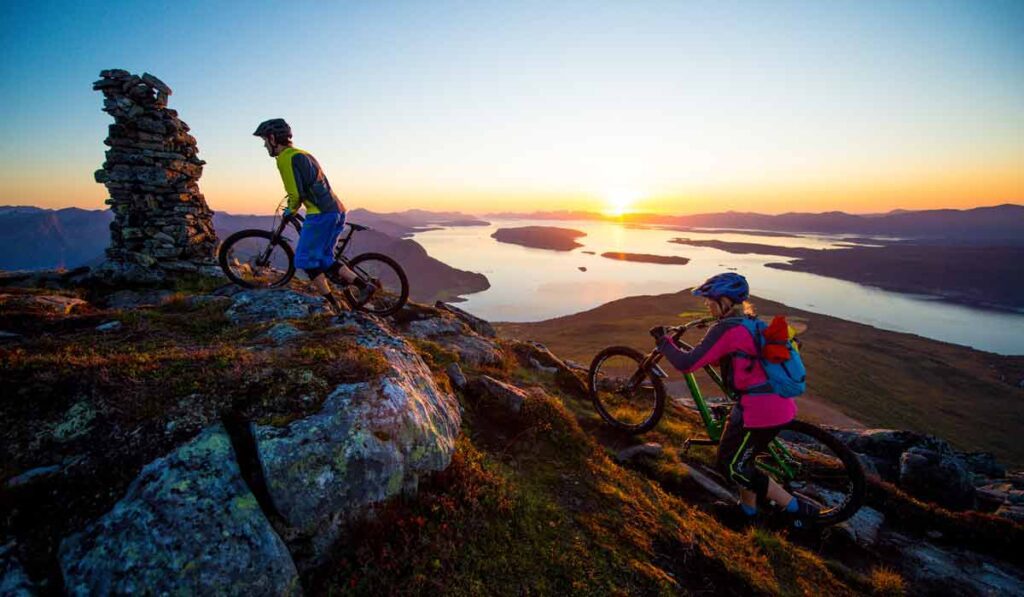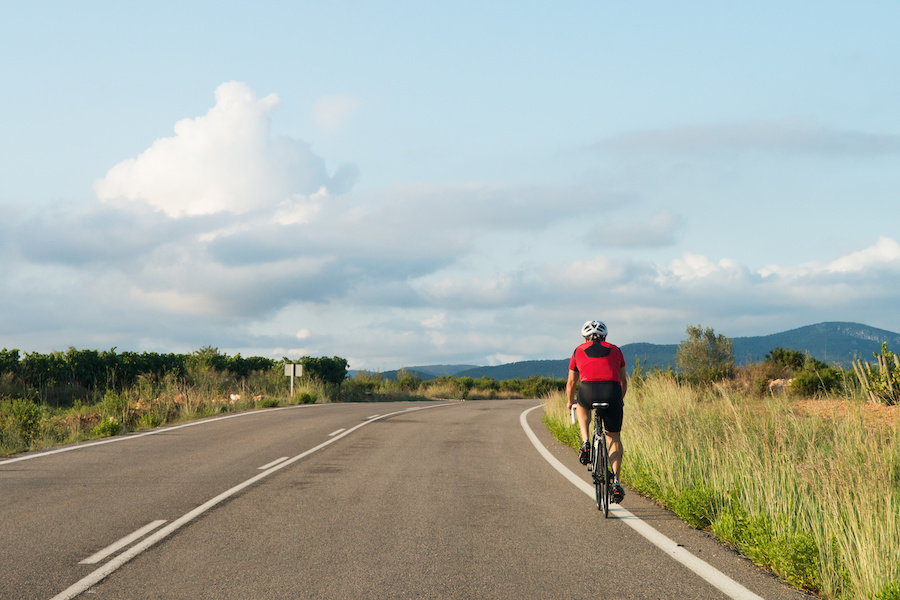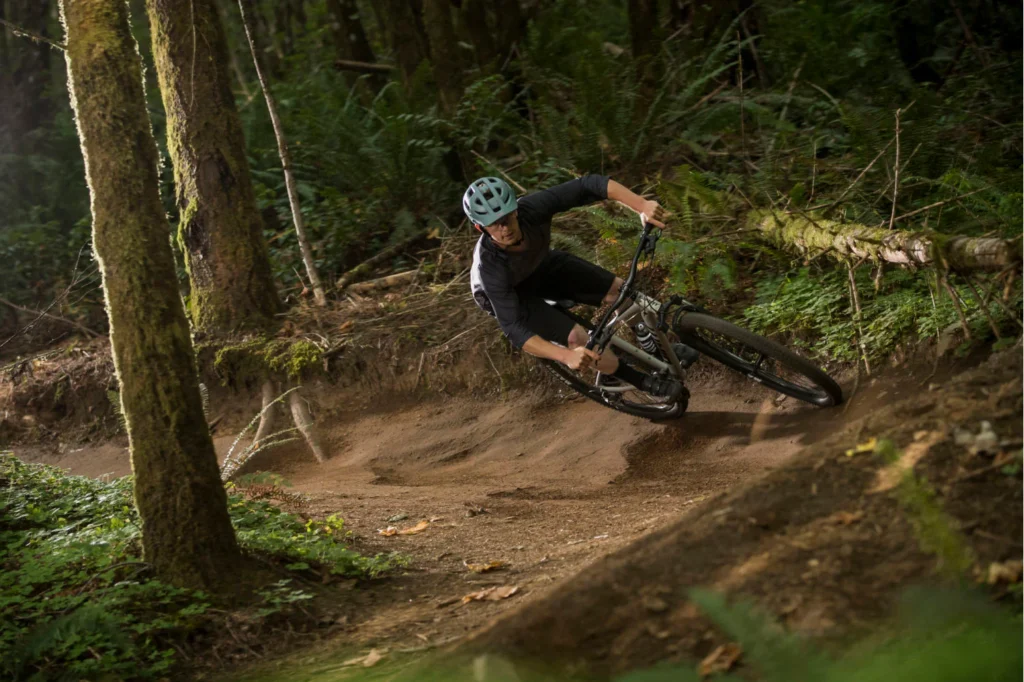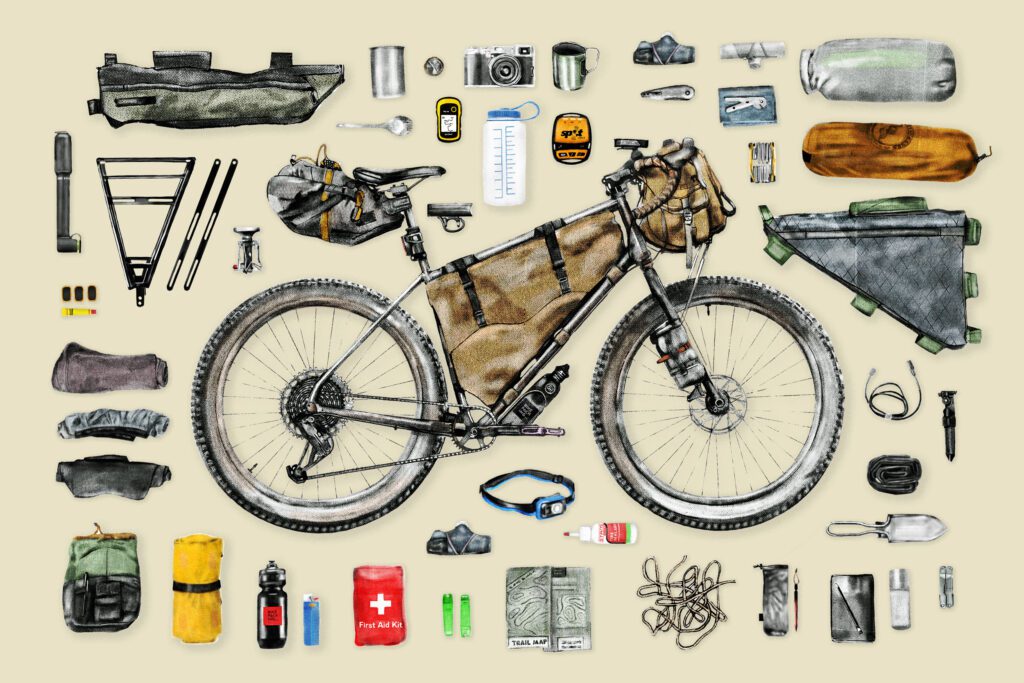


When it comes to the exhilarating world of mountain biking, one question that frequently echoes through the minds of adventurous riders is, “Can you ride a mountain bike anywhere?”
This inquiry arises from the inherent allure of mountain biking – the freedom to explore untamed landscapes, conquer challenging trails, and revel in the natural beauty that surrounds us.
Mountain biking beckons enthusiasts with the promise of unbridled adventure, but the answer to this query is not as straightforward as one might think.
As we delve into the intricate realm of mountain biking, we’ll navigate the terrain of regulations, environmental stewardship, and responsible riding practices.
While the spirit of mountain biking thrives on a sense of boundless exploration, it’s imperative to understand that there are parameters, both ethical and legal, that dictate where and how you can ride a mountain bike.
So, fasten your helmet, check your tire pressure, and let’s embark on a journey to unravel the answer to the question: “Can you ride a mountain bike anywhere?”
Understanding the Freedom of Mountain Biking



Mountain biking is more than just a recreational activity; it’s an embodiment of freedom. Picture yourself on the saddle, the crisp mountain air filling your lungs as you pedal through dense forests, rocky trails, and rolling meadows.
Read More : How to ride over rocks
This is where the essence of mountain biking truly shines – in the unbridled sense of exploration it offers.
The Trail as Your Canvas:
Mountain biking presents a canvas that knows no boundaries. Unlike road cycling, which often adheres to predictable pavement, mountain biking embraces the wild. You have the liberty to choose your path, to venture into uncharted territory, and to traverse landscapes that seem untouched by human presence.
Whether it’s the depths of a remote forest, the peaks of rugged mountains, or the serenity of a lakeside trail, your mountain bike can take you there.
No Restrictions, Only Possibilities:
Unlike other forms of outdoor recreation, mountain biking thrives on a lack of constraints. There are no lane dividers, no speed limits, and no defined routes. Your mountain bike becomes an extension of your adventurous spirit, enabling you to tackle a variety of terrains and challenges.
From steep descents that get your adrenaline pumping to technical ascents that test your skill, every trail offers a unique experience.
Connecting with Nature:
Riding through the untamed outdoors on a mountain bike allows you to forge a profound connection with nature. You’ll witness the changing seasons, the vibrant colors of the landscape, and the diverse wildlife that calls these areas home.
The sensation of wind in your face and the sounds of nature enveloping you create a sensory experience like no other.
The Meditative Flow:
Mountain biking can also be a meditative pursuit. As you navigate the twists and turns of the trail, your mind finds solace in the rhythmic motion of pedaling. The act of focusing on the trail ahead clears your thoughts, offering a mental escape from the demands of daily life.
In essence, understanding the freedom of mountain biking is about recognizing that it transcends the boundaries of conventional cycling.
It grants you the autonomy to explore the great outdoors on your terms, to forge a deep connection with nature, and to experience the sheer joy of venturing into uncharted territory. It’s a symphony of adventure, self-discovery, and communion with the natural world that defines the spirit of mountain biking in a truly unique way.
The Legal Landscape: Where Can You Ride?



Navigating the legal landscape of mountain biking is akin to deciphering a complex trail map. Each jurisdiction, from national parks to local municipalities, can have its own set of rules and regulations.
Read More : Mountain bike for commuting
In this detailed exploration of “The Legal Landscape: Where Can You Ride?” we’ll unravel the intricacies of riding your mountain bike within the bounds of the law, all while maintaining a uniquely engaging perspective.
National Parks and Public Lands: The Scenic Playground
Imagine cruising through the heart of a national park, the grandeur of nature unfolding before your eyes. While these iconic landscapes may seem like the ultimate playground for mountain bikers, it’s imperative to recognize that even within these natural wonders, there are restrictions.
National parks, forests, and public lands often have designated trails for mountain biking, each subject to specific rules. Some may permit biking on all trails, while others limit it to certain paths to protect sensitive ecosystems.
The Dance of Regulations: Understanding the legal framework within these areas is akin to a dance. It’s not just about where you can ride; it’s also about when you can ride. Seasonal restrictions might come into play to protect wildlife during breeding seasons or to preserve trails during wet conditions.
These regulations are in place to ensure that your mountain biking adventures do not harm the fragile balance of these natural wonders.
Local Regulations: The Tapestry of Rules
Zoom in from the grand landscapes to your local trails, and you’ll encounter a tapestry of rules and regulations. Municipalities, counties, and even neighborhoods can have their own ordinances governing mountain biking.
These rules often address issues like trail access, permissible hours of riding, and trail maintenance responsibilities. As a mountain biker, you become a steward of your local trails, playing a vital role in ensuring their sustainability and accessibility.
Trail Advocacy: Many local mountain biking communities engage in trail advocacy efforts, working with land managers and local governments to expand trail networks and maintain existing routes.
This collaboration between riders and authorities can lead to the creation of more opportunities for responsible mountain biking.
Private Lands: The Hidden Gems
Beyond public lands and local trails, there are privately owned lands that may open their doors to mountain bikers. These hidden gems often come with their own sets of rules and access agreements.
Gaining permission to ride on private lands is a privilege, and respecting the landowner’s wishes is paramount to maintaining these opportunities for all riders.
The Golden Rule: Whether you’re riding on public lands, local trails, or private property, the golden rule of responsible mountain biking is to “leave no trace.” This means respecting the environment, fellow trail users, and any rules or regulations that apply to the area.
It’s about preserving the beauty of the outdoors for future generations of riders.
In conclusion, understanding “The Legal Landscape: Where Can You Ride?” in the world of mountain biking involves recognizing that each trail has its own unique legal framework.
It’s a dynamic and sometimes intricate dance between rider and regulator, where respecting the rules is not just a legal requirement but also a means to ensure that the spirit of mountain biking continues to thrive in harmony with the environment.
So, as you embark on your mountain biking adventures, take a moment to study the legal map of your chosen terrain, and let your ride be a testament to both adventure and responsibility.
Trail Types and Terrain: Where to Ride Safely



Diverse Trails: A Playground of Possibilities
Picture yourself standing at the trailhead, your mountain bike ready to conquer the unknown. The world of mountain biking is a realm of diversity, where each trail type and terrain offers a distinct adventure.
From rolling meadows to rocky descents, here’s a unique exploration of “Trail Types and Terrain: Where to Ride Safely.”
Singletrack Serenity: Singletrack trails are the heart and soul of mountain biking. They are typically narrow, winding paths that snake through forests, meadows, and mountainsides. These trails demand precise bike handling and provide an intimate connection with the natural surroundings.
Riding on singletrack is like a dance, where every twist and turn keeps you engaged with the terrain.
Flow Trails: The Art of Fluid Riding: Flow trails are designed to be, as the name suggests, a flowy and exhilarating experience. They feature sculpted berms, rollers, and jumps that allow riders to maintain momentum and rhythm.
Flow trails are perfect for those seeking an adrenaline rush and the feeling of being one with the trail.
Technical Challenges: Rocks and Roots: For those who crave technical challenges, rocky and rooty trails deliver the ultimate test of skill. These trails are strewn with obstacles that require precise bike control.
Riding them is like solving a puzzle with your bike, where conquering each rock or root is a triumph.
Downhill Descents: Gravity’s Playground: Downhill trails are where gravity takes the lead. These trails are often accessed via ski lifts or shuttles, and they provide a downhill thrill ride. Riders can reach high speeds and tackle jumps and drops.
While exhilarating, downhill trails require specialized equipment and a keen sense of safety.
Mountain Summits: Epic Ascents: Some mountain bikers seek the challenge of ascending peaks. These trails often involve steep climbs and hike-a-bike sections, but the reward is reaching stunning vistas and conquering high-altitude adventures. Riding to a mountain summit is a test of endurance and determination.
Urban Trails: The City’s Secrets: Don’t forget the urban terrain. Mountain biking can thrive even in urban environments. City parks, greenways, and bike-friendly neighborhoods offer opportunities for riders to explore their own backyard in a unique way.
Safety First: Riding the Right Terrain
Riding safely begins with choosing the right terrain for your skill level and experience. Novice riders might find flow trails and well-maintained singletrack more accessible, while seasoned riders can challenge themselves on technical trails or downhill courses.
Always evaluate the terrain, be prepared with the appropriate gear, and ride within your comfort zone.
The Joy of Progression: One of the joys of mountain biking is the opportunity for progression. As you gain experience and confidence, you can gradually tackle more challenging terrain. It’s a journey of growth and skill development that keeps the sport exciting and dynamic.
In conclusion, the world of mountain biking offers a vast tapestry of trail types and terrains, each with its own unique character and challenges.
Whether you seek the tranquility of singletrack, the exhilaration of flow trails, or the technical feats of rocky paths, there’s a trail out there waiting to be explored.
The key to riding safely is to choose the terrain that matches your skill level, respect the environment, and always be prepared for the unexpected twists and turns of the trail ahead.
So, as you embark on your next mountain biking adventure, let the terrain be your guide to an unforgettable ride.
Exploring Off the Beaten Path: Off-Roading Adventures



The Allure of Off-Roading
Picture this: You’re on your trusty mountain bike, surrounded by the tranquil beauty of the great outdoors.
But instead of well-groomed trails, you’re navigating through uncharted territory, forging your path through dense forests, rocky outcrops, and wild landscapes. This is the allure of off-roading adventures in mountain biking.
The Off-Roading Experience: Off-roading in mountain biking is all about leaving established trails behind and embracing the unknown. It’s a journey that takes you into the heart of nature, where you become an explorer, seeking hidden treasures along the way.
Off-roading is a testament to the versatility of mountain bikes, designed to handle the rigors of rough and rugged terrain.
The Thrill of Exploration
Beyond the Trail Map: When you venture off the beaten path, you’re not confined by trail maps or marked routes. Instead, you become a trailblazer, relying on your instincts, skills, and a sense of adventure. This type of riding is the essence of exploration, where every pedal stroke takes you deeper into the wilderness.
Remote Wilderness: Off-roading often leads you to remote and secluded areas where the beauty of nature is unspoiled. These are the places where you can truly disconnect from the hustle and bustle of everyday life and immerse yourself in the serenity of the outdoors.
Challenges and Rewards
Technical Prowess: Off-roading adventures present a unique set of challenges. You’ll encounter steep ascents, technical descents, and obstacles like fallen trees and rocky stream crossings. This type of riding demands a high level of technical prowess and adaptability.
The Satisfaction of Self-Reliance: Off-roading requires a self-reliant approach. You’ll need to carry essential supplies, navigate using maps or GPS devices, and have the skills to handle unexpected situations. The self-sufficiency aspect adds to the sense of accomplishment when you successfully complete an off-roading journey.
Environmental Responsibility
Leave No Trace: With the freedom of off-roading comes a great responsibility to protect the environment. It’s essential to adhere to the principles of “Leave No Trace,” ensuring that your off-roading adventures do not harm fragile ecosystems or disturb wildlife.
Respecting the environment is paramount to preserving these off-the-grid experiences for future generations.
Conclusion: The Off-Roading Odyssey
In the world of mountain biking, off-roading adventures represent the pinnacle of exploration and self-discovery. They are a celebration of the untamed wilderness, where riders become pioneers, forging their way through uncharted landscapes.
The thrill of off-roading lies not just in conquering challenges but also in the profound connection with nature it fosters.
So, if you’re seeking a unique and immersive mountain biking experience, consider venturing off the beaten path. Embrace the call of the wild, navigate the unmarked trails, and let the spirit of adventure guide your off-roading odyssey.
It’s a journey that promises unforgettable moments, personal growth, and a deep appreciation for the beauty of the natural world.
Gear Up: Essentials for Riding Anywhere



The Gear that Fuels the Adventure
Imagine gearing up for a mountain biking excursion. Your trusty bike is waiting, and the great outdoors beckon. But before you hit the trails, there’s one crucial aspect that deserves your attention – your gear.
Mountain biking is more than just a hobby; it’s a dynamic sport that demands the right equipment to ensure your safety, comfort, and enjoyment. In this exploration of “Gear Up: Essentials for Riding Anywhere,” we’ll journey through the gear that fuels your mountain biking adventure.
The Steed: Your Mountain Bike
Your journey begins with the heart of the adventure – your mountain bike. This is not just any bike; it’s a specialized machine designed to conquer rugged terrain. Mountain bikes come in various styles, including hardtail and full-suspension, each tailored to specific riding conditions.
Choose one that suits your riding preferences, whether it’s the agility of a hardtail for cross-country journeys or the plush comfort of a full-suspension for challenging trails.
The Frame: The frame is the foundation of your bike. It determines its strength, weight, and handling characteristics. Frames can be made from materials like aluminum, carbon fiber, or steel, each with its unique properties.
Wheel Size: Mountain bike wheels come in different sizes, with 26-inch, 27.5-inch, and 29-inch being the most common. Wheel size impacts how your bike rolls over obstacles and handles terrain, so choose according to your riding style.
Tires: Tire choice is crucial. Wider tires offer more traction and stability, making them ideal for technical trails, while narrower tires are faster on smoother surfaces. Tire pressure plays a role in grip and comfort, so adjust it based on the terrain.
Safety First: Protective Gear
Mountain biking can be exhilarating but also challenging, which is why safety gear is paramount.
Helmet: A quality helmet is non-negotiable. It protects your head in case of falls or collisions. Look for helmets with MIPS technology for enhanced safety.
Gloves: Gloves provide grip, cushioning, and protection for your hands, which are often the first point of contact in a fall.
Pads and Armor: Depending on your riding style, you may need knee and elbow pads, as well as body armor for added protection.
The Essentials: Riding Apparel
Clothing: Dress appropriately for the conditions. Moisture-wicking jerseys, padded shorts, and breathable layers are your allies for comfort during the ride.
Footwear: Proper mountain biking shoes offer grip on pedals, comfort for long rides, and often have reinforced toe caps for protection.
Tools and Accessories
Multi-Tool: A compact multi-tool is essential for on-trail adjustments and repairs.
Tire Repair Kit: Flat tires happen. Carry a repair kit with patches, tire levers, and a pump.
Hydration System: Stay hydrated with a hydration pack or water bottles mounted on your bike.
Navigation: Maps, GPS devices, or smartphone apps can help you navigate and track your rides.
Conclusion: Gear Up for Adventure
In the world of mountain biking, your gear is not just equipment; it’s your ticket to adventure. Whether you’re exploring scenic trails, tackling technical descents, or embarking on off-roading expeditions, having the right gear ensures a safe and enjoyable ride.
So, before you hit the trails, gear up with the essentials that match your riding style and destination. Your mountain biking adventure awaits, and with the right gear, there are no limits to where you can ride and explore.
Conclusion
In conclusion, the question, “Can you ride a mountain bike anywhere?” embodies the spirit of freedom and exploration that defines mountain biking.
While the allure of venturing off the beaten path and conquering diverse terrain is undeniably enticing, it’s essential to remember that responsible riding practices, adherence to local regulations, and environmental stewardship are paramount.
Mountain biking offers a world of possibilities, from rugged singletrack trails to off-roading adventures, but it’s our collective responsibility to ensure that we answer the question, “Can you ride a mountain bike anywhere?” with a resounding “Yes,” while also preserving the beauty of our natural landscapes for future generations of riders.
FAQ’s
Can you ride a mountain bike anywhere?
No, you cannot ride a mountain bike anywhere. Riding is subject to local regulations, respecting the environment, and maintaining trail integrity. Responsible riding is essential.
Can I ride a mountain bike around town?
Yes, you can ride a mountain bike around town. Mountain bikes are versatile and suitable for urban environments, offering an enjoyable and efficient means of transportation and exercise.
Are mountain bikes good for everyday use?
Yes, mountain bikes can be suitable for everyday use. They provide comfort, durability, and versatility for commuting, running errands, and recreational riding in various terrains.
Can I use mountain bike for long distance?
Yes, you can use a mountain bike for long-distance rides. While not as efficient as road bikes, mountain bikes can handle extended journeys, offering comfort and durability on varied terrain.
Do you need to be fit for mountain biking?
Yes, being reasonably fit is beneficial for mountain biking. It requires stamina, strength, and agility to handle challenging terrains and enjoy the sport safely and effectively.



Welcome to Bikegenics, where passion meets performance! We are a leading online destination for all things related to mountain biking, dedicated to providing you with top-notch gear, expert advice, and an immersive community to fuel your two-wheeled adventures. With a commitment to excellence and a deep love for the sport, we strive to elevate your biking experience to new heights.
